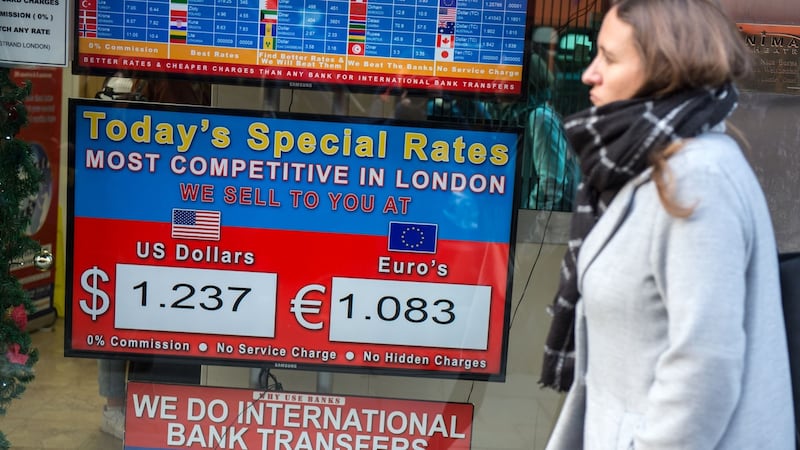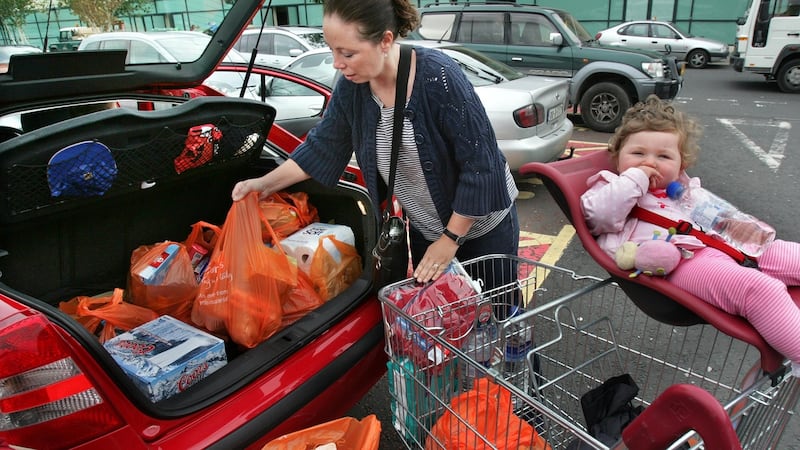Since the Brexit referendum sterling has declined steadily, losing around 15 per cent in total against the euro – and is now falling again.
It is down 4 per cent against the euro since mid-April and as fears of a chaotic no-deal exit rise it could drop further. The sterling exchange rate is vital for Irish exporters, for tourism, for cross-border and online shopping and for the the tens of thousands of people and businesses who operate some parts of their lives in the two currencies.
As no-deal fears rise, the question is : how low can it go? And what does it all mean?
1. The slow decline:
When the UK voted to leave the EU in June 2016, there were forecasts of a sharp and sustained fall in the value of sterling, prompted by a heavy hit to the UK economy.
In the event, the currency did drop in the wake of the referendum and by October that year was hovering around 90p against the euro – it did fall very briefly at one stage overnight to close to 94p in a “flash fall” in Asian markets – compared to 78p-79p before the referendum.
But then sterling steadied a bit, as it became clear that that the initial hit to the UK economy was less than the worst fears. Since then the UK currency has risen and fallen largely prompted by the Brexit negotiations – in periods when the talks were going badly it has tended to fall and vice versa.
It exceeded 93p briefly in August 2017. But is has generally traded between 85p and 88.5p. Now, as fears again grow of a chaotic no-deal Brexit, sterling is again on the slide, trading over 90p against the euro, its weakest level since early January. Against the US dollar, sterling is around $1.24, its lowest level for more than two years.

2. Where next?
Sterling will be driven almost purely by politics in the coming weeks. This week hardline comments on the backstop by the Conservative leadership contenders sent the currency down, and then it recovered after EU negotiator Michel Barnier appeared open to talks. This is just a warm-up for the fireworks to come.
A chaotic no-deal crash-out threatens to hit UK growth hard and possibly lead to an emergency cut in interest rates by the Bank of England, both reasons to sell sterling.
Moves could be volatile, especially during August when trading volumes are low and market volatility indicators and short-positions in the currency – speculators selling now in the hope of buying sterling back more cheaply later – are all pointing to a rocky ride.
"Currency moves these days are driven more by growth prospects than interest rates differentials,"said economist Megan Greene of the Harvard Kennedy School. This has meant that sterling has depreciated against the euro even as the ECB has suggested it might cut interest rates further.
For sterling we now need to consider two things . What might rising fears of a no-deal do to its value in the coming weeks – and what an actual no-deal could mean at the end of October, or at a later date.
“A no deal Brexit is definitely not priced into the markets yet,” according to Greene, “and so if one were to materialise I think we could expect a significant fall in sterling relative to the euro”.
One thing to watch is that currencies typically have touch points – previous highs or lows which can be seen as targets.
John Fahey, chief economist at AIB Treasury says that if fears of a no-deal build, sterling could head back towards the 93p level, which represents the euro's post referendum high two years ago against sterling.
If a no-deal happens, or starts to look inevitable, things could get even worse. Fahey says the currency could come under “ severe pressure if a no-deal Brexit becomes an increasingly likely prospect” possibly falling by 10 to 15 per cent, which could see parity breached.
At Ulster Bank in Dublin, economist Simon Barry says that the 98p level reached during the financial crisis in early 2009 could quickly become a target for markets and parity could be in prospect,"depending on just how disorderly is the scenario, both in terms of the economics and the politics" .
One thing which is hard to forecast is how much of such a big fall would come before the no-deal actually happened – if it appeared a racing certainty, a lot could take place before the date.
The final point to note is that analysts agree that the UK currency will bounce – significantly – if a no-deal exit is seen to somehow be taken off the table, or the whole thing is subject to another lengthy delay. With a lot of bad news on Brexit “ priced in” any bounce could be significant enough, though of course would depend on whether no-deal appeared to be moving off the table, or it was just another delayed decision.

3. What it means
Sterling weakness is one of the big Brexit risk factors for Ireland, mainly because it makes selling into the UK more difficult for Irish exporters. It also threatens tourism from the UK, as the pound in the British tourist’s pocket will not go as far here.
Exports to Britain have remained relatively solid since the Brexit vote , but declined last year and continue to fall as a percentage of total exports.
In the first five months of this year, exports to Britain rose by 9 per cent, but were largely static in the sterling-exposed domestic sectors such as food. In total almost 7,000 Irish firms export goods to the UK – and for around half it is their only export market so this is a big deal for the areas like food, engineering and SMEs.
Research by Ibec, the business lobby group, suggests that around 90p is a key “pinch-point” for Irish businesses selling into the UK.
Fergal O’Brien. IBEC’s policy director, says that many firms have prepared for volatility using strategies such as hedging, but that the currency move “ still hurts and costs” .
A key issue for businesses and jobs will be not only how much further sterling falls, but also for how long sterling weakness is sustained, he said.
IBEC research has shown that in the food sector, for example,the 2009 sterling weakness caused a noticeable fall-off in exports to the UK. It estimates that every 1 per cent fall in sterling against the euro cuts food exports by 0.7 per cent – so a 10 per cent fall could cut exports by 7 per cent, or around €300 million.
Remember the food sector is also threatened by post-Brexit tariffs – possible taxes on their imports into the UK – which would cause massive problems in sectors like beef.
So these sectors face a potential double whammy. The real concern for Irish manufactures is becoming uncompetitive and disappearing off the order sheets of the big UK buyers, which they fought so hard to get on in the first place.
For importers from the UK into Ireland the story is different, with prices falling in euro terms, helping to hold down prices and inflation. However in some sectors - notably food – this currency price benefit would be more than offset by the cost of tariffs, or special import taxes, and other additional costs from new bureaucracy facing importers, which would be imposed on goods entering from the UK after a no-deal Brexit. An ESRI study has estimated that this would add over €1,200 to the average Irish annual shopping bill.
Sterling weakness would be noticeable in other areas to consumers. In the short term, it will make it a good time to visit Belfast or London, for example. It is also good news for those crossing the border to shop, or buying from UK retailers onlines.
Online shopping from the UK will become more complicated and costly if a no-deal Brexit actually occurs, as has been reported, involving tax payment on delivery and a more complicated returns process.
Will we see a flood of cross-border shopping, as happened in 2009 when sterling last approached parity and was in the mid 90’s against the euro for a prolonged period? CSO research suggested that cross-border shoppers spent €458 million in the year running up to the first quarter of 2018.
Some 14 per cent of households took a cross-border shopping trip, rising to 44 per cent in border areas.
So a short-term surge could hit Border retailers and the Irish exchequer, as happened in 2009 when estimates were of an increase of 25 per cent of more in cross-border shopping.
Ian Talbot of Chambers Ireland says concern will rise quickly among border retailers if sterling loses further ground – and that the threat of the Republic moving first on imposing minimum unit pricing for alcohol is another factor worrying retailers. The industry has called on the Republic to move in tandem with the North on this.
However if a no-dea Brexit actually happens, then – in theory at least – there will be limits on the amont of alcohol and cigarettes which people can bring into the Republic, a €150 limit for customs declarations and in some cases VAT implications. Whether and how these rules might be enforced remains anyone’s guess.
Sterling weakness is also a key factor for the motor trade as second hand cars flood in from the North and the UK. More than 100,000 imports were registered in Ireland last year and at rates above 90p the industry says buyers will increasingly travel themselves to source a vehicle.
Of course importing a car if a no-deal Brexit actually happens will get more costly and involve more bureaucracy, likely wiping out the benefits of UK imports. As with all cross-border shopping and trade, it is all going to get a lot more complicated after Brexit.










